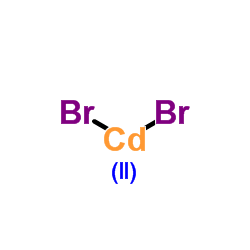7789-42-6
| 中文名 | 溴化镉 |
|---|---|
| 英文名 | cadmium(2+),dibromide |
| 中文别名 | 溴化鎘 |
| 英文别名 |
cadmium(2+) dibromide
Cadmiumbromide (8CI) MFCD00015996 EINECS 232-165-1 Cadmium dibromide |
| 密度 | 5,192 g/cm3 |
|---|---|
| 沸点 | 863°C |
| 熔点 | 567°C |
| 分子式 | Br2Cd |
| 分子量 | 272.219 |
| 闪点 | 863°C |
| 精确质量 | 271.740021 |
| 外观性状 | 黄色晶体或粉末 |
| 储存条件 | 保持贮藏器密封 放入紧密的贮藏器内,储存在阴凉,干燥的地方。 |
| 稳定性 | 1.如果遵照规格使用和储存则不会分解;溶于水、醇和丙酮,微溶于醚。微溶于乙醚,稍溶于丙酮,溶于乙醇、盐酸,易溶于水。 |
| 计算化学 | 1.疏水参数计算参考值(XlogP):无 2.氢键供体数量:0 3.氢键受体数量:2 4.可旋转化学键数量:0 5.互变异构体数量:无 6.拓扑分子极性表面积0 7.重原子数量:3 8.表面电荷:0 9.复杂度:0 10.同位素原子数量:0 11.确定原子立构中心数量:0 12.不确定原子立构中心数量:0 13.确定化学键立构中心数量:0 14.不确定化学键立构中心数量:0 15.共价键单元数量:3 |
| 更多 | 1. 性状:无色结晶或白色结晶颗粒,久置或风化逐渐变黄。在干燥空气中风化。 2. 密度(g/mL 25ºC):5.192 3. 熔点(ºC):583 4. 沸点(ºC,常压):963 5. 闪点(ºC,):863 6. 溶解性(mg/mL):易溶于热水。溶于冷水、乙醇、盐酸。微溶于丙酮、乙醚 |
|
Section 1: Product Identification Chemical Name:Cadmium bromide, anhydrous, 99% CAS Registry Number:7789-42-6 Formula:CdBr2 EINECS Number:232-165-1 Chemical Family:metal halide Synonym:Cadmium dibromide
Section 2: Composition and Information on Ingredients IngredientCAS NumberPercentACGIH (TWA)OSHA (PEL) Title Compound7789-42-6100%0.002mg/m30.005mg/m3 Section 3: Hazards Identification Irritating to skin, eyes and respiratory tract. Harmful by inhalation, in contact with skin and if swallowed. May Emergency Overview: cause cancer. Primary Routes of Exposure:Ingestion, inhalation Eye Contact:Causes mild to severe irritant to the eyes. Skin Contact:Causes slight to mild irritation of the skin. irritating to the respiratory tract. Harmful by inhalation. May cause coughing, headache, shortness of breath, Inhalation: chest pains and pulmonary edema. Harmful if swallowed. Ingestion may lead to sudden nausea, vomiting, bloody diarrhea, weakness, Ingestion: convulsions, and death. Harmful by inhalation, in contact with skin and if swallowed. irritating to skin, eyes and respiratory tract. Acute Health Affects: Ihalation may cause metallic taste, cough, chest pain, pulmonary edema, liver and kidney damage. Prolonged exposure may cause loss of sense of smell, weight loss, liver, lung, skeletal and kidney damage. Chronic Health Affects: Cadmium is a recognized carcinogen of the connective tissue, lungs, and the liver. NTP:Yes IARC:Yes OSHA:No SECTION 4: First Aid Measures Immediately flush the eyes with copious amounts of water for at least 10-15 minutes. A victim may need Eye Exposure: assistance in keeping their eye lids open. Get immediate medical attention. Wash the affected area with water. Remove contaminated clothes if necessary. Seek medical assistance if Skin Exposure: irritation persists. Remove the victim to fresh air. Closely monitor the victim for signs of respiratory problems, such as difficulty Inhalation: in breathing, coughing, wheezing, or pain. In such cases seek immediate medical assistance. Seek medical attention immediately. Keep the victim calm. Give the victim water (only if conscious). Induce Ingestion: vomiting only if directed by medical personnel. SECTION 5: Fire Fighting Measures Flash Point:not applicable Autoignition Temperature:none Explosion Limits:none Extinguishing Medium:none required Special Fire Fighting Procedures:No special fire fighting procedures required. Hazardous Combustion andToxic dusts contain cadmium Decomposion Products: Unusual Fire or Explosion Hazards: No unusual fire or explosion hazards. SECTION 6: Accidental Release Measures Spill and Leak Procedures:Small spills can be mixed with vermiculite or sodium carbonate and swept up. SECTION 7: Handling and Storage Handling and Storage:Store material in a tightly sealed container. Will adsorb moisture if handled in a moist environment. SECTION 8: Exposure Controls and Personal Protection Eye Protection:Always wear approved safety glasses when handling a chemical substance in the laboratory. Skin Protection:Wear appropriate chemical resistant gloves and protective clothing. Ventilation:Material may form a fine dust. If possible, handle the material in an efficient fume hood. In the absence of adequate ventilation a respirator should be worn. The use of a respiratory requires a Respirator: Respirator Protection Program to be in compliance with 29 CFR 1910.134. Ventilation:Material may form a fine dust. If possible, handle the material in an efficient fume hood. Additional Protection:No additional protection required. SECTION 9: Physical and Chemical Properties Color and Form:white pwdr. Molecular Weight:272.22 Melting Point:567° Boiling Point:863°C Vapor Pressure:no data Specific Gravity:5.192 Odor:none Solubility in Water: SECTION 10: Stability and Reactivity Stability:hygroscopic Hazardous Polymerization:no hazardous polymerization Conditions to Avoid:contact with moisture Incompatibility:active metals Decomposition Products:none SECTION 11: Toxicological Information RTECS Data:Oral (rat); LD50: 322 mg/kg. Oral (rat); LD50: 733 mg/kg/90D-C. Carcinogenic Effects:Carcinogen (as Cd) Mutagenic Effects:No data available Tetratogenic Effects:No data available SECTION 12: Ecological Information Avoid release into the environment. Very toxic to aquatic organisms. May cause long-term adverse effects in Ecological Information: the aquatic environment. SECTION 13: Disposal Considerations Disposal:Dispose of according to local, state and federal regulations. SECTION 14: Transportation Shipping Name (CFR):Cadmium compounds Hazard Class (CFR):6.1 Additional Hazard Class (CFR):NA Packaging Group (CFR):III UN ID Number (CFR):UN# 2570 Shipping Name (IATA):Cadmium compound Hazard Class (IATA):6.1 Additional Hazard Class (IATA):NA Packaging Group (IATA):III UN ID Number (IATA):UN# 2570 SECTION 15: Regulatory Information TSCA:Listed in the TSCA inventory. SARA (Title 313):Title compound see Category Code N078 for reporting. Second Ingredient:none SECTION 16 - ADDITIONAL INFORMATION N/A |
|
毒理学数据: LD50:4000mg/Kg(大鼠经口);4720mg/Kg(兔经皮)。 LC50:9400mg/m3,2小时(小鼠吸入)。 生态学数据: 对水是极其危害的,若无政府许可,勿将材料排入周围环境。 CHEMICAL IDENTIFICATION
HEALTH HAZARD DATAACUTE TOXICITY DATA
|
| 危害码 (欧洲) | Xn,N |
|---|---|
| 风险声明 (欧洲) | 20/21/22-50/53 |
| 安全声明 (欧洲) | S60-S61 |
| 危险品运输编码 | UN 3077 9/PG 3 |
| WGK德国 | 3 |
| RTECS号 | EU9935000 |
| 包装等级 | III |
| 危险类别 | 6.1 |



